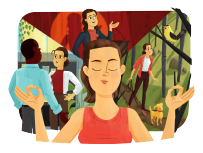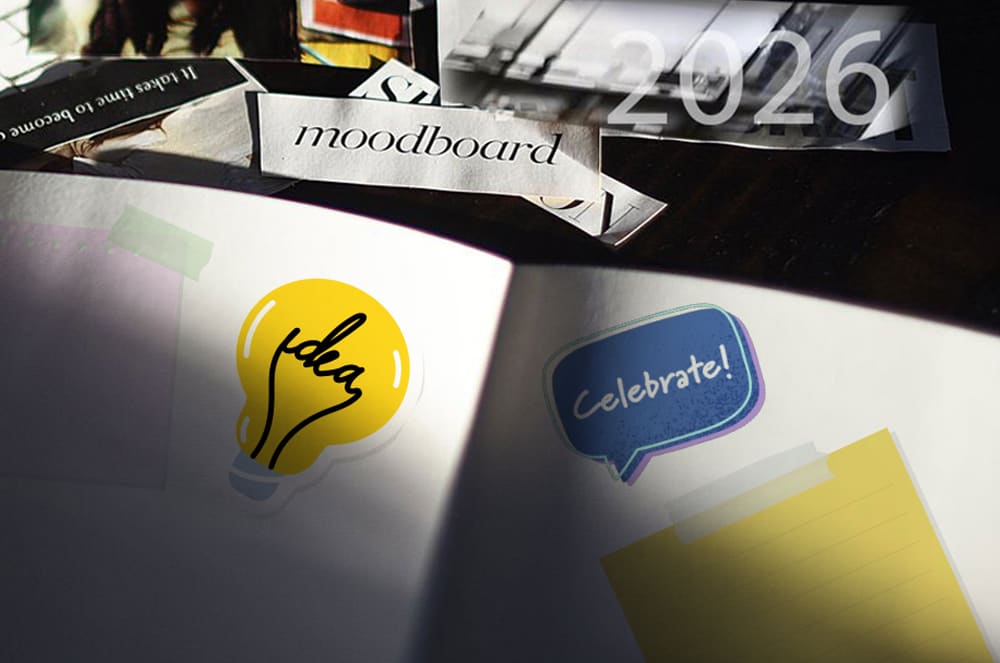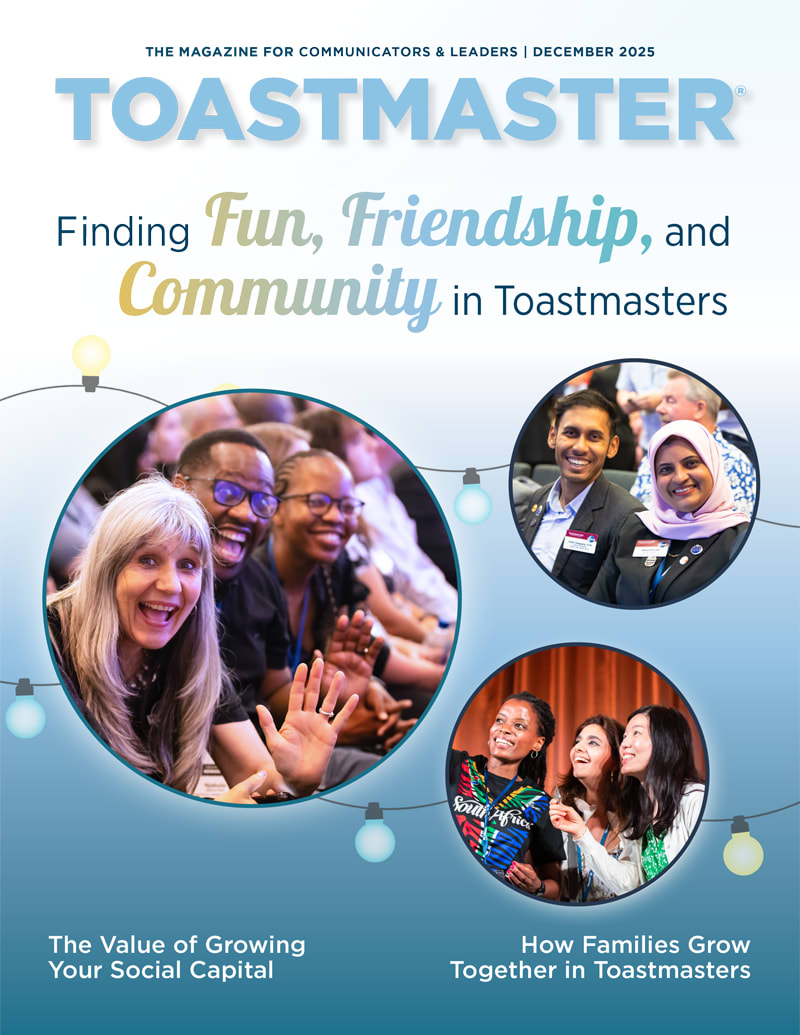
Do you ever wish there was a magic tool you could use to manage anxiety, increase resilience, create a sense of calm, and boost your chances of succeeding at everything you do?
Fortunately, that tool exists inside you: the combination of your mind and imagination. Meditation and visualization are powerful practices that can transform your public speaking experience. They help you tap into the quiet power of your mind to calm your nerves, focus your energy, and achieve the success you’re capable of.
When I was in college, I was trying to process the trauma of a childhood loss. My mind was scattered, and I was at the whim of my emotions. When I heard there was a Zen center at the top of the mountain next to my college in Claremont, California, my curiosity was piqued. I visited and found that I had a lot of difficulty sitting still and focusing on my breathing. Taking this as a challenge, I resolved to keep meditating until I could think of my childhood trauma without having a strong emotional reaction, and until I could succeed at calming my mind.
The practice itself was simple: sit still, breathe deeply, and count from one to 10. If a wandering thought snagged my attention, I would start again at one. I was amazed at how long it took me to get to 10 without being distracted. Almost 40 years later, I still meditate nearly every morning. It sets the tone for a calm, productive day and now, I can reach 10 with ease.
For centuries, meditation and visualization have been used to cultivate clarity, focus, and inner peace. Today, science affirms their benefits in enhancing creativity and reducing anxiety, especially in public speaking.
The Science of Meditation
The first step to confident speaking is managing anxiety. A study reported in Neuroscience News found that regular meditation decreases cortisol, the body’s primary stress hormone, and reduces the risk of stress-related diseases.
Similarly, a study in the Journal of Anxiety Disorders showed that eight weeks of mindful meditation significantly reduced symptoms of social anxiety. Participants displayed decreased activation in the amygdala—the brain’s fear center—when facing social stressors. If fear of public speaking holds you back, meditation is your ticket to serenity.
"Before winning the World Championship, I spent more time in mental preparation—meditation and visualization—than in physical practice. Your speech happens twice: first in your mind, then onstage."
—Craig ValentineMeditation is frequently categorized as a mindfulness practice. Mindfulness involves focusing on the present moment without judgement.
In his book, Wherever You Go, There You Are, Jon Kabat-Zinn, Ph.D., founder of the Mindfulness-Based Stress Reduction program, explains, “The best way to capture moments is to pay attention. This is how we cultivate mindfulness. Mindfulness means being awake. It means knowing what you are doing.”
Many speakers find that simply focusing on the moment at hand—not worrying about the future or dwelling on the past—melts their performance anxiety.
How to Meditate
Meditation can be practiced in many ways. The goal is to quiet the mind and enhance concentration. To try meditating, follow these steps:
- Find a quiet space, sit comfortably, close your eyes, and take slow, deep breaths.
- Let your thoughts drift by like clouds; don’t hang onto them.
- Set a timer for five to 15 minutes.
- Count your breaths or watch the breath entering and leaving your body. If you prefer a guided meditation, use an app like Headspace or Calm or search the internet for other options.
Emily Fletcher, author of Stress Less, Accomplish More, writes that meditation allows us to access a state of restful alertness, where the mind is calm yet sharp and focused. This balance is crucial for delivering a compelling speech.
With regular practice, you’ll find it easier to calm your nerves before stepping onto the stage.
Visualization: Creating Success in Your Mind
After my first book was published, I did a flurry of media appearances and public speaking engagements. Then, after years away, I was asked to speak in front of 40 people. I was terrified.
My doctor, a master of aikido (a Japanese martial art that emphasizes meditation), gave me an exercise. He held out his arm and asked me to push down on it. It was easy. Then, he extended it again, but this time, it was rock solid. “The first time, I only thought about my arm,” he explained. “The second time, I imagined it as a firehose of energy. That made my body strong.”
He advised me to visualize my speech: “What’s the worst that could happen?” I imagined stumbling over my words or forgetting my lines. He reassured me: “Even if that happens, your life will go on. Your family—and your dog—will still love you.” Somehow that thought reassured me: This speech would not be the end of my life, no matter how it turned out. This realization freed me to create a powerful mental image of myself striding across the stage and connecting with my audience.
That’s what visualization is: vividly imagining success so you feel it as reality. Athletes, pilots, and performers use this technique to enhance performance. Michael Phelps, American swimmer and winner of 23 Olympic gold medals, mentally rehearsed every race. He pictured exactly how the race would go, including the smell in the air, the taste of the water, the sounds he’d hear, and what he’d see on the clock.
Public speakers can also apply visualization. Here’s how to use it before a speech:
- Find a quiet space. Take three deep breaths to center yourself.
- Set the scene. Close your eyes and picture the venue. See the audience engaged, smiling, and nodding as you speak.
- Rehearse mentally. Visualize yourself delivering a smooth, confident speech. Feel the energy, hear the applause, and embrace your confidence.
- Prepare for challenges. Imagine handling technical glitches, skeptical audiences, or tough questions with ease.
Visualization primes your brain for success, reinforcing positive associations and reducing fear of the unknown. Research suggests it activates the same neural pathways as actual performance, improving confidence and focus. A study in the University of Dayton journal Basic Communication Course Annual found that visualization significantly reduced anxiety and increased the effectiveness of speakers.
Craig Valentine, 1999 World Champion of Public Speaking, credits much of his success to these techniques: “Before winning the World Championship, I spent more time in mental preparation—meditation and visualization—than in physical practice. Your speech happens twice: first in your mind, then onstage.”
Combining Meditation and Visualization
Meditation and visualization work best when used together. Meditation keeps you calm and present, while visualization mentally prepares you for success.
These techniques help inside and outside of Toastmasters. Meditation aids impromptu speaking, while visualization prepares you for structured speeches. Both practices can also enhance your performance in job interviews, negotiations, and other conversations.
For Toastmasters looking to advance from competent to compelling speakers, meditation and visualization offer a competitive edge. By mastering not just external delivery but mental preparation, speakers can achieve greater confidence, presence, and audience connection.
Elizabeth Danziger is founder of Worktalk Communications Consulting, an author of four books, and a columnist on Inc.com. She has taught business communication to companies throughout the United States for many years. You can reach her at lizd@worktalk.com. Her company sends out Writamins writing tips monthly. To receive them, sign up at worktalk.com.
Related Articles

Personal Growth
Mind Matters

Goal Setting
Visualize Your Goals

Personal Growth



 Previous
Previous

 Practical Tips for Meditation Beginners
Practical Tips for Meditation Beginners
 Previous Article
Previous Article